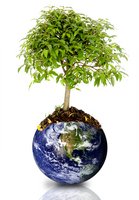Cloth-Diaper-Fabric
Organic Eco-Friendly Diapers
A sensible cloth-diaper-fabric for your baby? Choices of green-diapering methods and varieties of diapers sure have changed since I've had to even think about this twenty-five years ago.
As a young mother with a full-time job, a house to look after and a new baby that really questioned my confidence in myself to look after properly, I must say I felt more than a bit overwhelmed at the time.
In those days, we only had "weeks" off the job at the time, not a full year like new parents do now. Those were the fastest 12 weeks, and I returned to work "tired."
Anything I could do to find shortcuts and make the best use of my free moments were my priority with a newborn.
Eco green-diapering methods, cloth-diaper-fabric and carbon footprint reduction were the furthest things from my mind.
So, when my mother sent me 60 cloth-diapers from Sears, I did think about cost savings but that was about it. But, they were nothing like the soft organic fitted cloth diapers are now.
The organic-cloth-diapers have a much softer feel to them, and are made from chemical and pesticide free materials.
Prone to allergies? This cloth-diaper-fabric is a much better choice.
Pre-owned, recycled cloth diapers from hemp and woven fibers are made from a much more absorbant cotton.
Disposable soakers that can be placed in the diaper first are made from a biodegradable fabric that composts well.
There are no heavy plastics, fragrances or dyes. Liners are very similar, and can be flushed after they are soiled. This saves on the diaper itself as well as water and hydro.
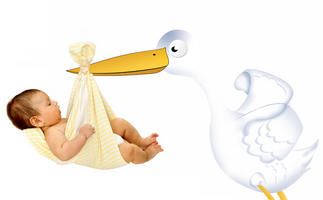
It was smelly and I think I always poured too much javex in it. Wasn't fun emptying it and cleaning it out.
We sure didn't have cloth diaper services in our town. Too bad! I remember hanging those diapers out on the clothesline. They were stained, badly out of shape and very rough to the touch. I remember trying to fold them into a perfect square and they just wouldn't form that way. I also remember I always wanted to load up my hands with skin cream after I handled them. I can't imagine how my daughter felt in them.
Not to mention the fact, that not only was this type of cloth- diaper-fabric soaked so fast, EVERYTHING was soaked all the time and very frequently in one day.
Baby clothes, the crib bedding, the baby pads, crib blankets, my own clothes were constantly wet, and this meant double the laundry, double the water, double the energy.
(I had the rubber pants that fit over the diapers, but they were cheap, too big, didn't prevent leakage, and they ripped alot)
At that time, I didn't have a regular washer and dryer either. I had one of those "roll up to the sink" little spin washers....you know, 1 pair of pants and a towel maybe could only be washed at once.
A normal, much rougher and longer wash cycle, and high heat in a dryer will wear out anything much quicker. A short wash cycle, dryer cycle and the type of detergent you use will be factors that will contribute to the longetivity of your laundry.
Be sure to remove all solid waste as much and as soon as possible before washing. Detergents with fabric softeners add a "film" to the material that affects moisture absorption, so try to avoid those.
My husband could never find them. I came home one afternoon to find that he had attempted scotch tape, if you can imagine. Of course, it didn't hold, and the diaper was falling off. Not very effective.
Colorful cloth-diaper-fabric and better fitted too!
The organic-cloth-diapers now have some great features and characteristics.
They are one-sized for all different size babies and preformed.
There are adjustable snaps made to fit as the baby gets bigger. Some use velcro. No stickies or pins!
The layered cotton inside is better for absorption, and there is waterproofing on the outside. Soft on the skin, comfy and they should be dried on the line. They are made from natural sources that use organic pest control methods.
They also are also available in different colors.
Because they can also be pre-owned, they are lower in price and can be passed down as reusable baby diapers.
They became dusters of course. Now, this cloth-diaper-fabric cleaned up dirt well. I didn't have what is available now in terms of good diaper materials.
I had no knowledge of how to properly wash and dry them.
I didn't have any knowledge or concerns about the environment at the time.
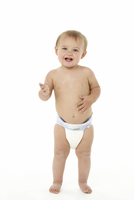 I bought cheaper disposable diapers and threw them in the garbage daily.
I bought cheaper disposable diapers and threw them in the garbage daily.
Did you know that regular disposable diapers account for the third largest source of waste in our dumps?
Billions of diapers per year are dumped and it can take hundreds of years for decomposition to ocurr. These are facts according to the Environmental Protection Agency.
Tons and tons of plastics and trees are sacrificed to make them.
It takes at least 4 times the energy to make one-time use diapers, and wastes more water than a good cloth diaper does.
The chemicals they contain, not to mention human waste, leaches continuously into the environment.
A single use diaper can encourage diaper rash, because even though your baby seems dry, the fact is, ammonia and feces are still in contact with the skin forming a perfect breeding ground for bacteria. This can give a false sense of "being dry" but with the cloth, you know much sooner if your child is soiled and are quicker to get them out of the diaper. They say that that this contributes to the reason why babies in cloth diapers are known to toilet train much faster.
In males, fertility risks later in life has been linked because of a higher temperature inside one-time use diapers.
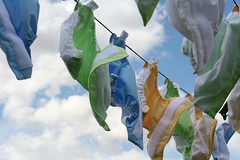
Looking for the perfect Eco-friendly shower Gift?
People are raving about Diaper Cakes. If you have heard of them, and would like to know how to make one, visit these Diaper Cake Instructions which have been provided here onsite. A wonderful gift for Mom! Get creative, and give it a try.
If you have made one of these already, you can submit your
photo on that page too. We'd love to see it!
Are you ready to consider green-diapering methods?
In a nutshell, what are the pros?
The newer cloth-diaper-fabric, namely organic-cloth-diapers can be easily and more efficiently disinfected.
Many more options now since my day with different styles, colors and convenience of use for fit.
They can be handed down to the next child. Money savings!
Hemp and cotton cloth-diaper-fabric brands are made without pesticides and chemical fertilizers and can reduce the instances of diaper rash.
Bamboo fitted diapers are very absorbent and very soft to the skin. They are much quicker drying.
Fair Trade Certified diapers offers a lovely hemp and cotton mix that don't contain bleaches or dyes. They have the added convenience of snap-on fasteners.
Eco-friendly-diapers have a much quicker drying time.
Organic-cloth-diapers provide good breathability and ventilation for the skin. They have the ability to evaporate the ammonia produced from urine very rapidly.
They do not contain perfumes, wood pulp, gels and chemicals that will pollute our soil and water systems.
These cloth-diaper-fabric varieties will cost a bit more, but depending on the type you buy, you will get more use out of them in the long run.
Make your baby more comfortable, reduce carbon-footprints and give them a try.
Leave Cloth-Diaper-Fabric
Return To Carbon Footprint Defined Home Page

Thanks For Your Support
Green Maven!
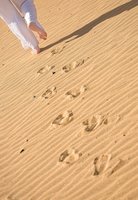
Popular Tips
Recycling Tips
Garage Sale Tips
Laundry Room
Green Travel
The Company Money
Eco-Baby Gift
Make A Diaper Cake
